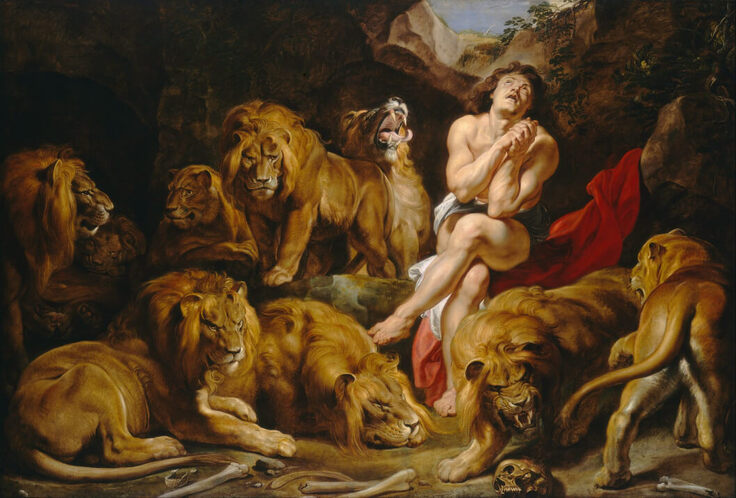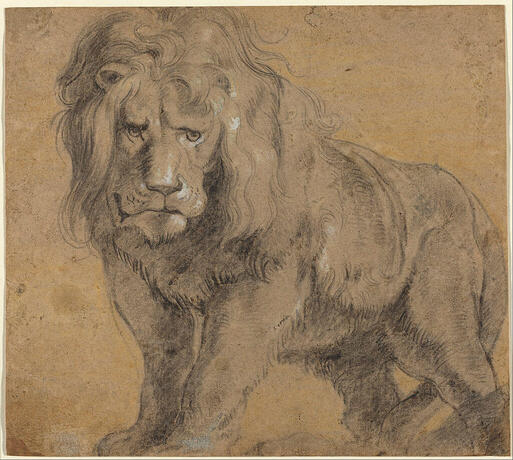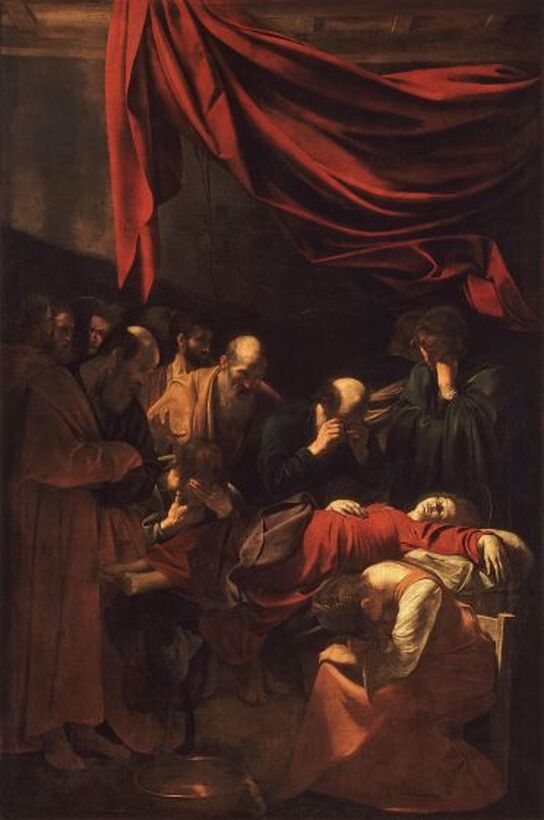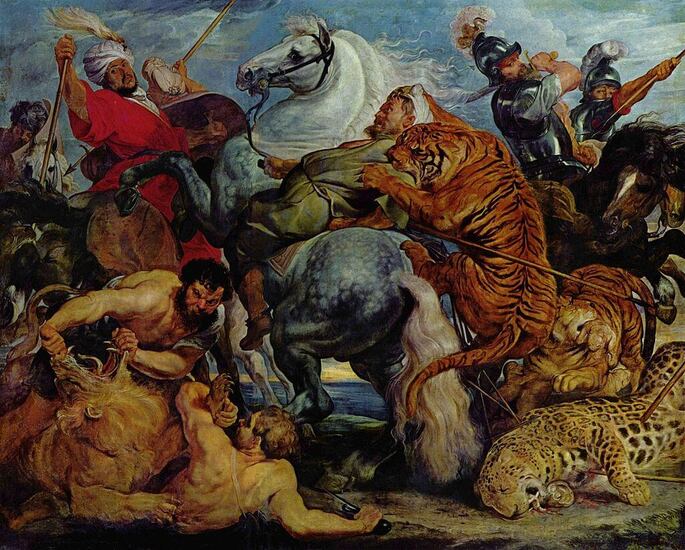|
Where? Gallery 45 of the National Gallery of Art
When? 1614-1618 Commissioned by? Unknown, but possibly Rubens created this as a showpiece for his studio. What do you see? Daniel is in the lions’ den surrounded by life-size lions. He sits on a colorful red cloth and has a white cloth wrapped around him. His body is tense with his legs crossed and his arms together. Given the light in the background, it seems that this painting captures the moment in the morning after Daniel has spent a full night in the den. Daniel is praying with his hands folded and he is looking up into the air. Some lions are sleeping, others are looking straight at us, and others are roaring or growling. There are nine lions and lionesses. In the foreground are the bones and a skull as evidence that the lions have already eaten some people. However, a young Daniel is sitting alive in the middle of the den. Notice that according to the Biblical story, Daniel was much older when he was thrown into the lions’ den, probably around 80 years old.
The painting is based on the Biblical story in the Book of Daniel, chapter 6. In short, Daniel is a high-level administrator for the Persian king Darius. He is doing so well that Darius wants to promote Daniel to be in charge of the full kingdom. The other administrators hatch a plan to trap Daniel. They convince Darius to issue a decree that in the next 30 days no one could pray to any god or human other than king Darius. As Daniel continues to pray to his God, he is sentenced to be thrown into the lions' den which nobody could survive. Darius says to Daniel before he is thrown in the den: “May your God, whom you serve continually, rescue you!” A big stone then covers the den.
The next morning Darius checks on Daniel and finds him still alive without any scratch. After that, Darius decided to throw all the administrators and their families in the lions’ den next, and they were all killed before they even reached the floor. Symbolism: The message of this painting reflects the message from the Biblical story of Daniel in the lions’ den: If you trust in God, he will protect you from no matter what, even from a pride of hungry lions. This story also symbolizes the resurrection of Jesus from the dead. The lions symbolize the powerful rulers on earth. Daniel is praying and looking upwards to Heaven, which symbolizes his faith in God. The skull in the foreground refers to Golgotha, the place where Jesus was crucified. The red cloth refers to the blood of Jesus.
Who is Rubens? Peter Paul Rubens (1577-1640) is a Flemish painter. He was born in Siegen, which is now in Germany, and died in Antwerp, Belgium. Together with Caravaggio, Rubens was one of the most well-known painters of his time. He used a Baroque style of painting.
In 1600, Rubens traveled to Italy, where he stayed for eight years. He spent time in Venice, Florence, and Rome and got inspired by the works of artists like Michelangelo, Raphael, and Titian. After this period he moved back to Belgium, where he set up his studio. Together with his many students and apprentices, he produced a very large number of paintings during his life. Fun fact: Rubens liked to include wild animals in his paintings and was often asked to paint hunting scenes. As he was one of the most dramatic painters of his time, he was perfectly suited to create some crazy hunting scenes. He could study most of these wild animals in the menageries that some of the richest people liked to have around that time. One thing he had to change, however, was to paint the animals like they would behave in the wild as opposed to the often tamed animals he observed in the menageries. In his different paintings, he included wild animals, such as bears, crocodiles, foxes, hippos, lions, tigers, and wolfs. These hunting scenes were always on commission, and they were a great way for Rubens to earn money. See, for example, the painting of The Tiger Hunt by Rubens. Interested in a copy for yourself? Poster or canvas
Written by Eelco Kappe
References:
1 Comment
|
Categories
All
|
- Home
- Blog
-
Museums
- Alte Pinakothek
- Art Institute of Chicago
- Baltimore Museum of Art
- Barber Institute of Fine Arts
- Bargello
- Barnes Foundation
- British Museum
- Church of Sant’Anastasia
- Cleveland Museum of Art
- Courtauld Institute of Art
- Detroit Institute of Arts
- Frans Hals Museum
- Galleria Borghese
- Gallerie dell'Accademia
- Getty Museum
- Guggenheim
- Hermitage Museum
- Kunsthistorisches Museum
- Kunstmuseum Basel
- Legion of Honor Museum
- Louvre
- Mauritshuis
- Metropolitan Museum of Art
- Musee d’Orsay
- Museum of Fine Arts in Boston
- Museum of Modern Art
- National Gallery in London
- National Gallery of Art
- National Museum in Poznań
- Norton Simon Museum
- Ny Carlsberg Glyptotek
- Palace of Versailles
- Palazzo Pitti
- Palazzo Vecchio
- Petit Palais
- Philadelphia Museum of Art
- Prado
- Pushkin Museum
- Ravenna Art Museum
- Rijksmuseum
- San Diego Museum of Art
- Santa Maria delle Grazie
- St. Peter's Basilica
- Städel Museum
- Statens Museum for Kunst
- Tate Britain
- Tate Modern
- Timken Museum of Art
- Uffizi
- Vatican Museums
- Wallace Collection
-
Artists
- Altdorfer
- Anguissola
- Berlin Painter
- Bosch
- Botticelli
- Boucher
- Bronzino
- Bruegel the Elder
- Brunelleschi
- Cabanel
- Caillebotte
- Canova
- Caravaggio
- Carpeaux
- Cezanne
- Cimabue
- David
- Degas
- Delacroix
- De Maria
- Donatello
- El Greco
- Fontana
- Fra Angelico
- Fragonard
- Gauguin
- Gentileschi
- Gericault
- Gonzalez-Torres
- Goya
- Hals
- Hogarth
- Hokusai
- Ingres
- Leonardo da Vinci
- Lippi, Filippo
- Longhi, Barbara
- Lorrain
- Makovsky
- Manet
- Massys
- Matisse
- Merian
- Michelangelo
- Mochi
- Modigliani
- Monet
- Panini
- Parmigianino
- Perugino
- Picasso
- Pisanello
- Raphael
- Rembrandt
- Renoir
- Reynolds
- Rivera
- Rodin
- Rubens
- Scultori
- Seurat
- Steen
- Tintoretto
- Titian
- Toulouse-Lautrec
- Turner
- Uccello
- Van der Weyden
- Van Dyck
- Van Eyck
- Van Gogh
- Van Hemessen
- Vasari
- Velazquez
- Vermeer
- Veronese
- Vigée Le Brun
-
Locations
- Books
- About Us




